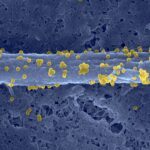Link to Pubmed [PMID] – 31849867
Link to DOI – 270210.3389/fmicb.2019.02702
Front Microbiol 2019 ; 10(): 2702
Listeria monocytogenes is a Gram-positive bacterium that can be found in a broad range of environments, including soil, food, animals, and humans. L. monocytogenes can cause a foodborne disease manifesting as sepsis and meningo-encephalitis. To evaluate signals of selection within the core genome of neuroinvasive L. monocytogenes strains, we sequenced 122 L. monocytogenes strains from cerebrospinal fluid (CSF) of Dutch meningitis patients and performed a genome-wide analysis using Tajima’s D and ω (dN/dS). We also evaluated the residual variation intolerance score (RVIS), a computationally less demanding methodology, to identify loci under selection. Results show that the large genetic distance between the listerial lineages influences the Tajima’s D and ω (dN/dS) outcome. Within genetic lineages we detected signals of selection in 6 of 2327 loci (<1%), which were replicated in an external cohort of 105 listerial CSF isolates from France. Functions of identified loci under selection were within metabolism pathways (lmo2476, encoding aldose 1-epimerase), putative antimicrobial resistance mechanisms (lmo1855, encoding PBPD3), and virulence factors (lmo0549, internalin-like protein; lmo1482, encoding comEC). RVIS over the two genetic lineages showed signals of selection in internalin-like proteins loci potentially involved in pathogen-host interaction (lmo0549, lmo0610, and lmo1290). Our results show that RVIS can be used to detect bacterial loci under selection.

